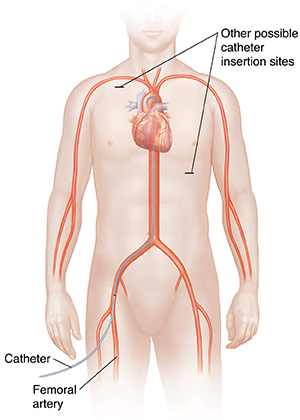Understanding Transcatheter Aortic Valve Replacement (TAVR)
Understanding Transcatheter Aortic Valve Replacement (TAVR)

The aortic valve controls blood flow from the heart to the body. In some people, the valve becomes scarred and stiff and has trouble opening. This is a condition called aortic stenosis. The heart then has to work harder to push blood through the narrowed heart valve to the rest of the body. Over time, the extra work can cause the heart muscle to weaken. This may lead to symptoms such as tiredness, shortness of breath, chest pain, and fainting. It can lead to heart failure.
In TAVR, the catheter is usually placed in the femoral artery in your groin. Sometimes, the catheter is placed through a small incision in your chest underneath the collarbone or an incision between the ribs. The doctor uses the catheter to bring the new valve to your heart. The new valve is made of cow or pig heart tissue and is mounted on a metal frame. The new valve helps improve blood flow from the heart to the rest of the body.
Reasons for TAVR
TAVR is an option if you are at higher risk traditional open-heart surgery to replace a valve. TAVR may be an option if you have:
Advanced age
A weaker heart
Previous heart surgery
A history of stroke
Chronic obstructive lung disease
Coronary artery disease
Kidney disease
Diabetes
Previous radiation treatment to the chest
Porcelain aorta, extensive calcium around the aorta that would make open heart surgery impossible or difficult
Frailty or physical disability that would make recovery from an open heart surgery challenging
TAVR may also be a choice for you for other reasons. A team of doctors makes the decision to do this surgery on a case-by-case basis.
Risks and possible complications
TAVR is very effective in most people. However, all medical procedures carry some risks and possible complications. Some common risks of TAVR include:
Bleeding or the need for a transfusion
Anemia (not enough red blood cells in the blood)
Blood clots
Infection
Collection of fluid around your heart
Confusion or memory problems
Damage to the heart
Damage to your blood vessels
Failure of the new valve
Heart attack
Heart rhythm problems that may require a pacemaker
Kidney damage or failure
Lung puncture
Stroke
Risks of anesthesia (including death)
Rarely, the new heart valve can move out of position after it has been implanted
Leaking of blood in or around the new heart valve
You may have other risks, depending on your medical condition. Be sure to talk with your doctor if you have any concerns before the procedure.
Life after a heart valve replacement
A new heart valve can help ease symptoms you may have had. These include pain or pressure in your chest, shortness of breath, and tiredness.
After the surgery, you will need to take aspirin or other blood-thinning medicine every day. You will likely also need to take an anti-platelet medication such as clopidogrel for a certain period of time. These medicines help prevent blood clots in your new valve.
You will need to take antibiotics before you have dental work, as prescribed by your healthcare provider. This is to help prevent bacteria from harming your new heart valve.
Your healthcare provider may tell you to make some lifestyle changes to protect your heart and make it stronger. These include exercise, quitting smoking, and keeping a healthy weight.
After your recovery from TAVR, you may be able to return to regular activities with a noticeable improvement in the symptoms from your heart valve disease. Be sure to talk to your doctor before starting any exercise program.
Updated:
August 14, 2018
Sources:
Repurposed from 135-79, Up To Date. Management of Patients with Prosthetic Heart Valves, Up To Date. Transcatheter Aortic Valve Replacement
Reviewed By:
Gandelman, Glenn, MD, MPH,Image reviewed by StayWell medical illustration team.,Snyder, Mandy, APRN